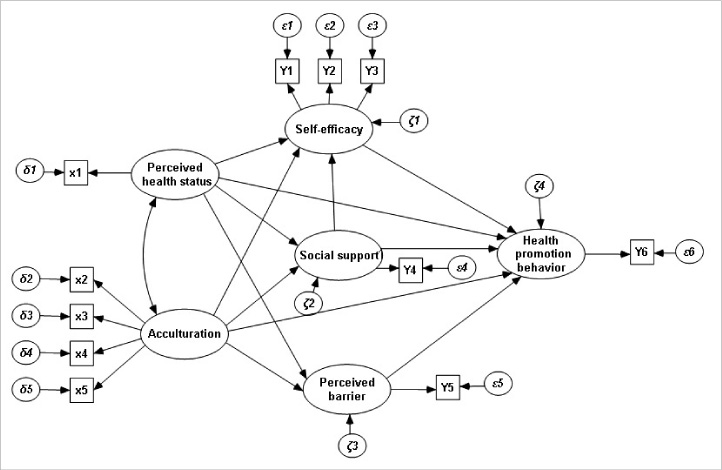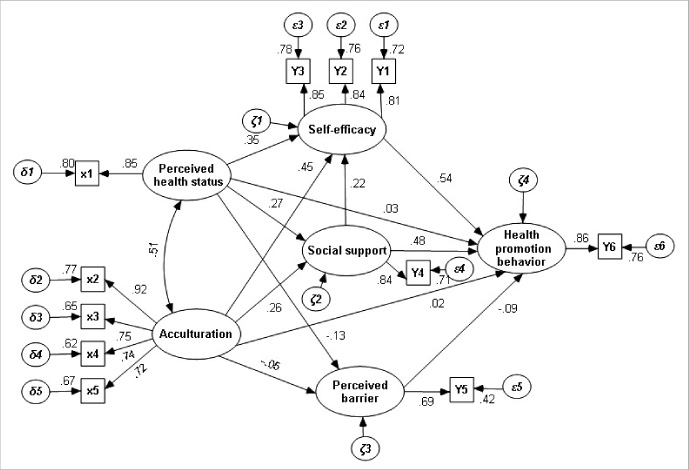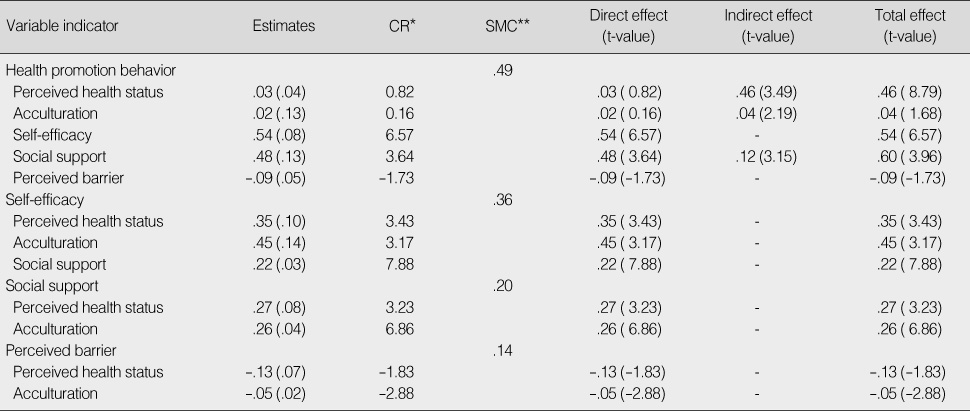Articles
- Page Path
- HOME > J Korean Acad Nurs > Volume 40(5); 2010 > Article
-
Original Article
- A Predictive Model on Health Promotion Behavior in Women who Immigrate for Marriage
- Namok Jeong, Myung Ha Lee
-
Journal of Korean Academy of Nursing 2010;40(5):695-704.
DOI: https://doi.org/10.4040/jkan.2010.40.5.695
Published online: October 31, 2010
1Assistant Professor, Department of Nursing, College of Medicine, Wonkwang University, Iksan, Korea.
2Professor, College of Nursing, Chonbuk National University, Jeonju, Korea.
- Address reprint requests to: Lee, Myung Ha. College of Nursing, Chonbuk National University, 664-14 1-ga, Deokjin-dong, Jeonju 561-756, Korea. Tel: 82-63-270-4481, Fax: 82-63-270-3127, leemh@jbnu.ac.kr
Copyright © 2010 Korean Society of Nursing Science
Abstract
-
Purpose
- This study was done to develop a model which explains factors influencing health promotion behavior in women who immigrate to Korea for marriage, and to verify the appropriateness of the model.
-
Methods
- The participants were 300 women who immigrate to Korea for marriage and settled in located in Jeonbuk Province, Korea. The data were collected with self-report questionnaires from October 10, 2007 through November 10, 2007. A total of 271 data sets were analyzed using the SPSS/WIN 12.0 and Amos 7.0 version.
-
Results
- Immigrant women's social support, self-efficacy, perceived health status, acculturation, and perceived barrier had an impact on their health promotion behavior. Social support was the most influential factor. All of these variables together explained 49% of the variance in health promotion behavior in immigrant women married to Korean men.
-
Conclusion
- In order to increase the health promotion behavior in immigrant women, intervention strategies to increase social support and self-efficacy for immigrant women should be developed.
- 1. Abbey A, Abramis DJ, Caplan RD. Effects of different sources of social support and social conflict on emotional well-being. Basic and Applied Social Psychology. 1985;6:111–129.Article
- 2. Bae BR. Structural equation modeling with Amos 7. 2007;Seoul, Chung Ram Book Publisher.
- 3. Bandura A. Self-efficacy: The exercise of control. 1997;9th ed.New York, NY, W.H. Freeman and Company.
- 4. Chen G, Gully SM, Eden D. Validation of a new general self-efficacy scale. Organizational Research Methods. 2001;4:62–83.ArticlePDF
- 5. Gu MO, Yu JS, Kweon IK, Kim HW, Lee EO. A review of research on self efficacy theory applied to health related behavior. The Journal of Nurses Academic Society. 1994;24:278–302.ArticlePDF
- 6. Han GS. Family life and cultural encounter of foreign wives in rural area. Korean Cultural Anthropology. 2006;39:195–219.
- 7. Janz NK, Becker MH. The health belief model: A decade later. Health Education Quarterly. 1984;11:1–47.ArticlePubMedPDF
- 8. Kang NY. Study in acquisition of Korean communitive competence for married migrant. 2007;Seoul, Seoul National University. Unpublished master's thesis.
- 9. Kim AH, Oh HE, Kim JS. A study on the relationship between social support, health promoting behaviors and depression among unmarried pregnant women. Korean Journal of Women Health Nursing. 2007;13:123–130.ArticlePDF
- 10. Kim BR. The present situation of the international marriage immigration and the adaptation of inter-nationally married women immigrants in Korean society. 2007;Seoul, Sogang University. Unpublished master's thesis.
- 11. Kim JH. The reliability and validity test of psycho-social well-being index (PWI). Journal of Korean Academy of Nursing. 1999;29:304–313.ArticlePDF
- 12. Kim YL. Women-immigrants' lives and their social-cultural accommodation-related policy for the multi-cultural society. Journal of Asian Women. 2006;45:143–189.
- 13. Marriage rate for Korean men and foreign women; Population movement study. Korea National Statistics Office. 2009;Retrieved January 20, 2010. from http://kosis.kr/nsportal.
- 14. Lawton MP, Moss M, Fulcomer M, Kleban MH. A research and service oriented multi-level assesment instrument. Journal of Gerontology. 1982;37:91–99.ArticlePubMed
- 15. Lee SJ, Kim SI, Lee PS, Kim SY, Park ES, Park YJ, et al. Construct a structural model for health promoting behavior of chronic illness. Journal of Korean Academy of Nursing. 2002;32:62–76.ArticlePDF
- 16. Lusk SL, Ronis D, Kerr MJ. Health-promoting lifestyles of blue-collar, skilled trade, and white-collar workers. Nursing Research. 1995;44:20–23.PubMed
- 17. Ministry for Health Welfare and Family Affairs. Results of survey about living status of immigrant women married to Koreans and counterplan of MHWFA. 2005;Author.
- 18. Moon JS. A study on the development of measuring tool for health belief in adult. 1990;Seoul, Yonsei University. Unpublished doctoral dissertation.
- 19. Park YJ, Lee SJ, Park ES, Ryu HS, Lee JW, Chang SO. A meta-analysis of explanatory variables of health promotion behavior. Journal of Korean Academy of Nursing. 2000;30:836–846.ArticlePDF
- 20. Pender NJ. Health promotion in nursing practice. 1996;3rd ed.Stamford CT, Appleton & Lange.
- 21. Schwarzer R, Leppin A. Social support and health: A theoretical and empirical overview. Journal of Social and Personal Relationships. 1991;8:99–127.ArticlePDF
- 22. Seol DH, Kim HS, Yoon HS, Lee HK, Yim KT, Chung KS, et al. Foreign wives's life in Korea: Focusing on the policy of welfare and health. 2005;Seoul, Ministry of Health and Welfare.
- 23. Shin YH, Jang HJ. Perceived exercise self-efficacy and exercise benefits/barriers of Korean adults with chronic diseases. Journal of Korean Academy of Nursing. 2000;30:869–879.ArticlePDF
- 24. Suinn RM, Khoo G, Ahuna C. The Suinn-lew Asian self-identity acculturation scale: Cross-cultural information. Journal of Multicultural Counseling and Development. 1995;23:139–148.Article
- 25. Walker SN, Hill-Polerecky DM. Unpublished manuscript. Psychometric evaluation of the health-promoting lifestyle profile II. 1996;Retrieved January 20, 2010. University of Nebraska Medical Center. from http://www.unmc.edu/nursing/docs/.
- 26. Beijing platform for action: A review of WHO activities. World Health Organization. 1999;Retrieved January 20, 2010. Geneva, World Health Organization. from www.who.int/CHS/WMH/.
- 27. Gender and health in disasters. World Health Organization. 2002;Retrieved January 20, 2010. Geneva, World Health Organization. from http://www.who.int/gender/other_health/en/genderdisasters.
- 28. Working with individuals, families and communities to improve maternal and newborn health. World Health Organization. 2003;Retrieved January 20, 2010. Geneva, World Health Organization. from http://www.who.int/7FCH7RHR/.
- 29. Yoo EK, Kim MH, Kim TK. A study of the relationship among health promoting behaviors, climacteric symptoms and depression of middle-aged women. Journal of Korean Academy of Nursing. 1999;29:225–237.ArticlePDF
- 30. Yun SN, Kim SY, Lee JY. Factors affecting women's behaviors for health promotion by life span. Korean Journal of Health Promotion and Diseases Prevention. 2004;4:207–215.
REFERENCES


Figure & Data
REFERENCES
Citations

- Structural Equation Modeling of Health Promotion Behavior on Migrant Workers: A Multi-Group Analysis Based on the Period of Residence
Hanna Jeong, Youngsuk Kim
Journal of Korean Academy of Nursing.2024; 54(1): 73. CrossRef - Effects of the Participatory Action Research on Reducing the Risk of Metabolic Syndrome in Adult Women
Yong-Sook Eo
International Journal of Environmental Research and Public Health.2021; 18(21): 11103. CrossRef - Factors Influencing the Physical Activity of Foreign Workers: Based on a Health Promotion Model
Jeong Eui Cho, Yeongmi Ha
Journal of Korean Academy of Community Health Nursing.2021; 32(3): 344. CrossRef - Health‐related quality of life among migrant workers: The impact of health‐promoting behaviors
Sunghye Cho, Hyeonkyeong Lee, Eui Geum Oh, Gwang Suk Kim, Yong‐Chan Kim, Chang‐gi Park
Nursing & Health Sciences.2020; 22(2): 318. CrossRef - The influences of socio‐individual determinants and health information seeking on health‐promoting behaviors among migrant women: A cross‐sectional study
Jung‐ae Ahn, Duckhee Chae
Japan Journal of Nursing Science.2019; 16(4): 481. CrossRef - Factors Associated with General Health Screening Participation among Married Immigrant Women in Korea
Jinhee Jeong, Yunhee Lee, Sung Hee Kwon, Jun-Pyo Myong
International Journal of Environmental Research and Public Health.2019; 16(20): 3971. CrossRef - Health of International Marriage Immigrant Women in South Korea: A Systematic Review
Jeong-Ah Ahn, Tiffany Kim, Eun Ha Roh, Ju-Eun Song
Journal of Immigrant and Minority Health.2018; 20(3): 717. CrossRef - Factors Influencing Health Promoting Behavior in Postpartum Women at Sanhujoriwon
Hyekyung Choi, Namok Jung
Korean Journal of Women Health Nursing.2017; 23(2): 135. CrossRef - Health Promotion Behavior of Chinese International Students in Korea Including Acculturation Factors: A Structural Equation Model
Sun Jung Kim, Il Young Yoo
Asian Nursing Research.2016; 10(1): 25. CrossRef - Exploring the health of female spouses from multicultural families: Examining the differences by their country of origin
Hyemee Kim
Journal of the Korea Academia-Industrial cooperation Society.2016; 17(3): 252. CrossRef - Factors Affecting Performance of Hand Hygiene by Parents of Hospitalized Infants
Su Jin Jin, Young Mi Song, Hye Young Han, Kyung Hwa Seo, Soon Jeong Kim
Child Health Nursing Research.2015; 21(4): 285. CrossRef - Study on Development of Physical Health Behavior Scale
OkKyungYang, Kim Haklyoung
Korean Journal of Social Welfare.2015; 67(3): 151. CrossRef - Development and Application of a Health Promotion Program for Marriage Immigrant Women
In Ju Seo, Jeong Sook Park
Korean Journal of Adult Nursing.2015; 27(2): 198. CrossRef - Effects of a Psychological Adaptation Improvement Program for International Marriage Migrant Women in South Korea
Won Hee Jun, Sung Sil Hong, Soo Yang
Asian Nursing Research.2014; 8(3): 232. CrossRef - Factors Affecting Health Status and Health Behaviors of Immigrant Women in Urban and Rural Areas
Jae-Ran Lim, Mi Sook Jung
Journal of the Korea Academia-Industrial cooperation Society.2014; 15(4): 2244. CrossRef - Immigrant Women's Health Status, Health Behaviors and Health Care Utilization
Jin Young Jeong, Moon Sook Shim
Journal of Korean Public Health Nursing.2014; 28(2): 200. CrossRef - Factors Associated with Physical Activity among Chinese Immigrant Women
Sung-Hye Cho, Hyeonkyeong Lee
Journal of Korean Academy of Nursing.2013; 43(6): 760. CrossRef - The Adjusting Process of Foreign Wives Married to Korean Husbands
Rosel L. Panuncio, Jeongyee Bae
Journal of Korean Academy of Psychiatric and Mental Health Nursing.2012; 21(1): 55. CrossRef - Effects of Newborn Care Education Program on Child-rearing Knowledge, Child-rearing Stress, and Child-rearing Self-efficacy of Immigrant Pregnant Women
Gi Min Lee, Yeon Hee Choi
Journal of Korean Public Health Nursing.2012; 26(3): 561. CrossRef - Pregnancy and Childbirth Experiences of Chinese Marriage Immigrant Women
김선희
JOURNAL OF THE KOREAN SOCIETY OF MATERNAL AND CHILD HEALTH.2012; 16(2): 170. CrossRef - Health Knowledge, Health Promoting Behavior and Factors Influencing Health Promoting Behavior of North Korean Defectors in South Korea
Myoung-Ae Choe, Myungsun Yi, Jung-An Choi, Gisoo Shin
Journal of Korean Academy of Nursing.2012; 42(5): 622. CrossRef - Married Immigrant Women's Utilization of Health Care and Needs of Health Services
Chunmi Kim, Myung Sook Park, Eun Man Kim
Journal of Korean Academy of Community Health Nursing.2011; 22(3): 333. CrossRef


Figure 1
Figure 2
Fit Index of Hypothetical Model
GFI=Goodness of fit index; RMSEA=Root mean square error of approximation; NNFI=Non-normed fit index; CFI= Comparative fit index; AGFI=Adjusted goodness of fit index; PNFI=Paranormed fit index; Q=nomed χ2.
Correlation Matrix among Measurable Variables
*p<.05; **p<.01.
x1=Perceived health status; x2-x5=Acculturation; Y1-Y3=Self-efficacy; Y4=Social support; Y5=Perceived barrier; Y6=Health promotion behavior.
Estimates and Effects of Predictor Variables in Modified Model (N=271)
*Critical ratio; **Squared multiple correlation.
GFI=Goodness of fit index; RMSEA=Root mean square error of approximation; NNFI=Non-normed fit index; CFI= Comparative fit index; AGFI=Adjusted goodness of fit index; PNFI=Paranormed fit index; Q=nomed χ2.
* x1=Perceived health status; x2-x5=Acculturation; Y1-Y3=Self-efficacy; Y4=Social support; Y5=Perceived barrier; Y6=Health promotion behavior.
*Critical ratio; **Squared multiple correlation.
 KSNS
KSNS
 E-SUBMISSION
E-SUBMISSION



 Cite
Cite

